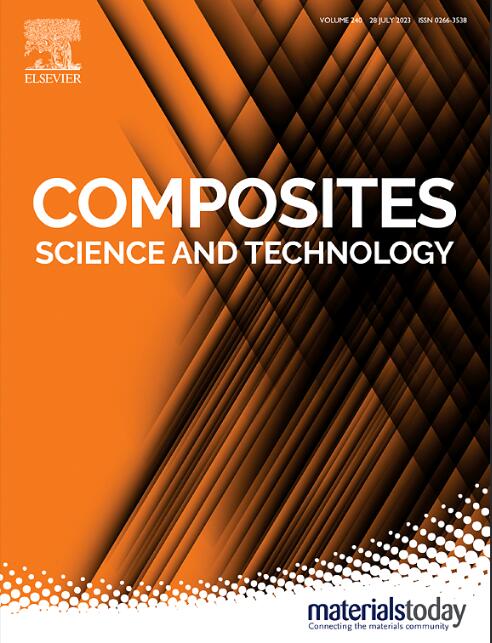用于应力可视化和损伤监测的环氧纳米复合材料的高灵敏度机械变色和高对比度多色开关
IF 8.3
1区 材料科学
Q1 MATERIALS SCIENCE, COMPOSITES
引用次数: 0
摘要
环氧树脂以其优异的综合性能在涂料和复合材料中得到了广泛的应用,但在应力传感和损伤检测方面也提出了新的挑战。机械变色,即材料在机械刺激下可以改变颜色,可能是解决这一问题的潜在工具。然而,对机械变色聚合物的研究主要集中在弹性体和凝胶上。对于刚性环氧热固性树脂,目前仍难以实现明显的机械变色,更不用说在不同的机械刺激下实现多色变化。在本研究中,二氧化硅纳米颗粒(NPs)被引入罗丹明(Rh)改性环氧树脂体系中,以改善其机械变色反应。当机械刺激纳米复合材料时,非均质界面周围的集中应力在这些区域引起大量的Rh开环反应,导致鲜艳的红色变化。此外,利用Rh片段的可视化特性,实现了对刚性颗粒附近应力集中效应的直接观察,并结合有限元分析阐明了机械显色性的增强机理。此外,还研究了NPs对环氧热固性树脂的多色机械致色性的影响。具有两种不同机械发色团的纳米复合材料表现出应力和时间依赖的五色变化,这是由于Rh和二硫化物部分的不同活化,而没有NPs的样品只表现出三色变化,对比度较低。该策略适合于实际应用,因为它能够通过高对比度多色开关显示材料的应力强度和应力历史。介绍了几个概念验证场景。本文章由计算机程序翻译,如有差异,请以英文原文为准。

Highly sensitive mechanochromism and high-contrast multicolor switching in epoxy nanocomposites for stress visualization and damage monitoring
Epoxy resins are widely used in coatings and composites due to their excellent comprehensive properties, but they also present new challenges in stress sensing and damage detection. Mechanochromism, which implies that a material can change color in response to mechanical stimulation, could be a potential tool to solve this problem. However, researches on mechanochromic polymers have primarily focused on elastomers and gels. For rigid epoxy thermosets, it is still difficult to achieve significant mechanochromism, let alone multicolor changes under different mechanical stimuli. In this study, SiO2 nanoparticles (NPs) are introduced into a rhodamine (Rh)-modified epoxy system to improve its mechanochromic response. When the nanocomposite is mechanically stimulated, concentrated stress around the heterogeneous interfaces induces massive ring-opening reactions of Rh in these areas, resulting in a vivid red color change. In addition, direct observation of the stress-concentration effect near the rigid particles is realized by using the visualization properties of the Rh moiety, and combined with finite element analysis to elucidate the enhancement mechanism of the mechanochromism. Furthermore, how the NPs affect multicolor mechanochromism of epoxy thermosets is also investigated. Nanocomposites with two different mechanochromophores exhibit stress- and time-dependent five-color variations due to the different activation of the Rh and disulfide moieties, whereas samples without NPs only show a triple-color change with lower contrast. This strategy is suitable for use in practical applications owning to its ability to display the stress intensity and stress history of a material through high-contrast multicolor switching. Several proof-of-concept scenarios are presented.
求助全文
通过发布文献求助,成功后即可免费获取论文全文。
去求助
来源期刊

Composites Science and Technology
工程技术-材料科学:复合
CiteScore
16.20
自引率
9.90%
发文量
611
审稿时长
33 days
期刊介绍:
Composites Science and Technology publishes refereed original articles on the fundamental and applied science of engineering composites. The focus of this journal is on polymeric matrix composites with reinforcements/fillers ranging from nano- to macro-scale. CSTE encourages manuscripts reporting unique, innovative contributions to the physics, chemistry, materials science and applied mechanics aspects of advanced composites.
Besides traditional fiber reinforced composites, novel composites with significant potential for engineering applications are encouraged.
 求助内容:
求助内容: 应助结果提醒方式:
应助结果提醒方式:


